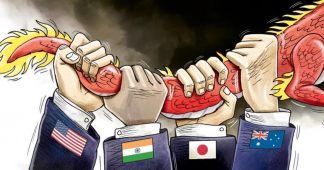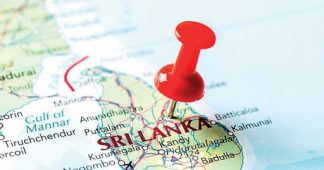By Lasanda Kurukulasuriya
Visits to Sri Lanka by two top foreign officials took place within a fortnight, recently. The optics of these tightly choreographed events may have obscured the nuts-and-bolts objectives sought by these big-powers who, as Quad members, are on the same page in their bid to counter China’s influence the region. With Sri Lanka going through its worst-ever economic crisis, on its knees for an IMF bail-out, diplomatic interactions with such visitors take place in the shadow of a glaring power imbalance.
The verbal sparring with US Under Secretary Victoria Nuland claiming that China is ‘not doing enough’ to help Sri Lanka get IMF funds, was to be expected. But little is known regarding other issues she may have discussed with President Ranil Wickremesinghe. Did she query the status of the New Fortress Energy project – where an American company gobbled up a 40% government stake in West Coast Power Ltd., which owns the Yugadhanavi power plant, along with an unsolicited contract to supply liquefied natural gas (LNG) needs for the next 5 years? The Sept. 2021 deal included rights to build an offshore floating storage and regassification unit (FSRU). Agreements were signed despite the Ceylon Electricity Board (CEB) unions protesting they had already called bids for these very purposes. Apparently the cabinet nod had been given though its members had not been briefed ahead. Two months later the agreement was tabled in parliament by Wickremesinghe (an opposition MP at the time). He said it breached parliamentary powers and privileges in its non-disclosure clause. The current status of the project remains unclear.
The NFE deal is also believed to have up-ended gas exploration efforts in the Mannar Basin, off the Northwestern coast. Experts were reported saying at that time that offshore blocks were just a few years away from production, and that losing the domestic market could deter prospective investors. Around the time the deal was executed, then energy minister Udaya Gammanpila was seeking investors abroad for oil and gas exploration. In parliament, he told a Consultative Committee on Energy that the Mannar Basin held $267 billion worth of oil and gas resources that could generate ‘three times the country’s total debt.’
Military exercise in Mannar
It appears that energy minister Kanchana Wijesekera has resumed the pursuit of Mannar’s valuable underwater resources, with Reuters reporting last month that government is preparing to issue exploration licenses for 900 off-shore blocks. Given the record of ad-hoc decision making however, with government entities working at cross-purposes with each other, it is anyone’s guess how attractive these offers will be to global players.
It is not without strategic significance that ahead of Nuland’s visit, the CARAT-MAREX military exercise between the US and Sri Lanka Navy and Airforce, took place mainly in Mullikulam, Mannar. The participation of US assets such as the P-8A Poseidon maritime surveillance aircraft and personnel of the US’s 7th Fleet point to its scale. US ambassador Julie Chung described it as “the largest bilateral military engagement between the U.S. and Sri Lanka and one that we in the United States consider critical to the security of the Indian Ocean Region.”
Nuland was in Sri Lanka Feb. 1 – 2, as part of a tour that encompassed Nepal, India, Sri Lanka and Qatar, Jan. 28 to Feb. 3. The Millennium Challenge Corporation (MCC) compact that Nepal’s parliament ratified a year ago had been high on Nuland’s agenda, with reports saying she stressed its implementation in all her meetings with political leaders. The MCC in Nepal had run into controversy earlier. There was “a strong lobby group … making a pitch against it saying it is tied to the Indo-Pacific Strategy, which is aimed at countervailing China,” the Kathmandu Post reported in 2021.
Indian External Affairs Minister S Jaishankar arrived in Colombo Jan. 19 against a backdrop of complex developments in the energy sector. Last year India’s Adani Group had secured an unsolicited contract for wind and solar power projects with estimated investments of $500 million, in Mannar and Pooneryn. That was ahead of then finance minister Basil’s visit to Delhi seeking desperately needed financial support. Opposition SJB MPs cried foul, accusing the group of ‘back door entry’ into the energy sector. The deal had been “inked the same day the National Thermal Power Corporation (NTPC) of India formalised an agreement with Ceylon Electricity Board (CEB), to jointly set up a solar power plant in Sampur, in Sri Lanka’s eastern Trincomalee district,” The Hindu reported. “However, the agreement involving the Adani Group was not made public by either side” the report added. SBJ MP Harsha de Silva, an economist, was quoted saying that it violated the Electricity (Amendment) Act of 2013 that mandates competitive bidding for all electricity generation. The current government has passed an amendment to the Electricity Act, seemingly to clear the way for Adani Group. India also signed up for renewable power projects on three islands off Jaffna after Sri Lanka, learning of India’s ‘security concerns,’ suspended the contract with a Chinese company that had secured it through the ADB’s competitive bidding process.
Energy hub in Trincomalee
The need to increase the share of renewables in Sri Lanka’s energy mix in the long term is not disputed. The stated goal is 70%. But of late, big power maneuvering in the energy sector has become more noticeable. Could involvement of foreign powers with strategic interests in the region lead to dependencies that complicate energy security, potentially threatening sovereignty? IndianOil already has a stake in oil storage and distribution through its subsidiary LIOC in Trincomalee, with its strategically located deep-water harbour. While India’s assurances to the IMF regarding support for Sri Lanka’s debt restructuring were the highlight of Jaishankar’s remarks, his statement revealed India’s interest in the energy sector:
“Energy security is today one of Sri Lanka’s most serious challenges. A search for solutions must necessarily encompass the larger region. Only then will Sri Lanka get the full benefit of scale. This country has enormous renewable energy potential that can become a sustainable source of revenue. It has the capability as well for Trincomalee to emerge as an energy hub. …. We have today agreed in-principle on a renewable energy framework that would take this cooperation forward.”
Details of the ‘framework’ agreed upon are not known. Foreign Minister Ali Sabry responding to a query from Newsfirst, reportedly said that much of the focus of discussion centred on establishing Trincomalee as an energy hub. According to the TV channel, he said the project includes the Trincomalee oil tank farm, but emphasised that no agreement had been signed yet in this regard. State minister Tharaka Balasuriya had echoed these sentiments, saying the Indian minister suggested that Sri Lanka could use locations like Trinco and Mannar to export energy to India, as Nepal does.
Nepal, Bhutan and Bangladesh are currently engaged in cross-border energy trade with India. Jaishankar’s suggestion here is that Sri Lanka should join the club, possibly envisaging a future scenario with a regional power grid. Theoretically, cross-border trade in energy is said to have benefits, with countries with an energy surplus being able to supply others at times they face a shortfall. Sri Lanka for example periodically faces a drop in hydro-power supply when there is drought. There is a need for transparency in any arrangements (or ‘frameworks’) that Sri Lanka agrees to, in relation to the totally new activity of cross-border energy trading. Will decisions be guided by those with relevant background, expertise and vision, or by shortsighted and/or corrupt politicians? The dire energy crisis the country faces, and circumstances that created it, do not inspire public trust.
President Wickremesinghe has expressed support for Indian involvement in the development of Trincomalee. Speaking on the Trincomalee District Strategic Development Plan in October he said “We are working with India on renewable energy with the aim of making Trincomalee an energy hub based on the existing relations between Trincomalee and India.” It is unusual to refer to a foreign state having ‘relations’ with a district in Sri Lanka.
In an article on ‘The surge of geopolitics in South Asia’s energy trade,’ Aditiya Valiathan Pillai warns that India’s approach to cross-border trade in electricity is political. New rules issued by the government “define the contours of the South Asian electricity market, placing clear limits on who can buy from and sell into India” says the author, an Associate Fellow at the Centre for Policy Research in Delhi. “This has ramifications for the electricity markets of Bangladesh, Nepal and Bhutan which, to varying degrees have aligned their energy futures with the Indian market. The new rules show that India’s approach is unmistakably political. It attempts to balance China’s growing influence in the region with developmental aims, both its own and the region’s,” according to Pillai.
We remind our readers that publication of articles on our site does not mean that we agree with what is written. Our policy is to publish anything which we consider of interest, so as to assist our readers in forming their opinions. Sometimes we even publish articles with which we totally disagree, since we believe it is important for our readers to be informed on as wide a spectrum of views as possible.









